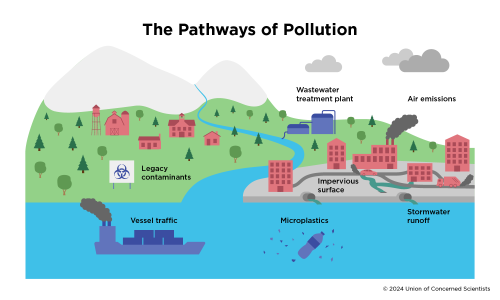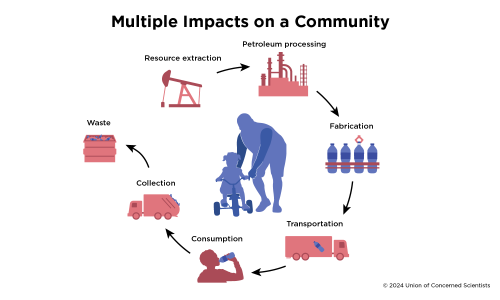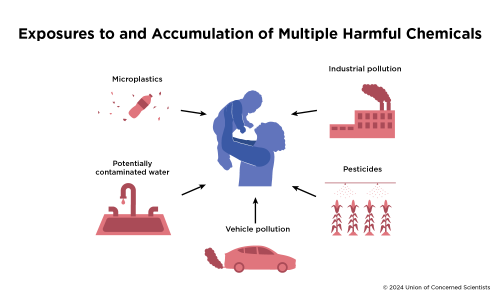Across the United States, health and environmental policies do too little to protect people and communities from harmful chemicals and pollution in the real world. One key reason is that the nation's environmental laws and rules consider each chemical or facility in isolation, but no one is exposed to one chemical at a time from one source at a time.
The real world exposes all of us to a multitude of harmful chemicals and through a number of pathways—from products we use in our homes and workplaces, to facilities in our neighborhoods that actively pollute the air and water, to legacy pollution that has accumulated in our community’s water, soil, and food chains. Those exposures combine with health stressors that systemic racism and unjust public policies often intensify: barriers to getting good food, existing health conditions, and poor access to health care.
Research and advocacy by environmental justice (EJ) leaders and experts are driving a new approach to regulating chemical and pollution exposures. Pushed by local and statewide organizers seeking to reduce real-world harms in overburdened communities, cities and states are enacting laws and regulations that assess and reduce what are known as “cumulative impacts.” Federal agencies, similarly propelled by advocates, are beginning to acknowledge past regulatory gaps and incorporate language that assesses and addresses cumulative impacts into new rules and policy guidance.
The Guide is a resource to help community, statewide, and national organizing, research, and campaigns drive changes that protect us from cumulative chemical and pollution harms—especially in disproportionately impacted and overburdened communities.
The Community Guide to Cumulative Impacts
Introduction to the Community Guide and Cumulative Impacts
Across the United States, health and environmental policies do too little to protect people and communities from harmful chemicals and pollution in the real world. One key reason is that the nation's environmental laws and rules consider each chemical or facility in isolation, but no one is exposed to one chemical at a time from one source at a time.
The real world exposes all of us to a multitude of harmful chemicals and through a number of pathways---from products we use in our homes and workplaces, to facilities in our neighborhoods that actively pollute the air and water, to legacy pollution that has accumulated in our community's water, soil, and food chains. Those exposures combine with health stressors that systemic racism and unjust public policies often intensify: barriers to getting good food, existing health conditions, and poor access to health care. This all adds up to harm people and communities.
About the Guide and Cumulative Impacts
Research and advocacy by environmental justice (EJ) leaders and experts are driving a new approach to regulating chemical and pollution exposures. Based on what actually happens in our communities, the movement to reduce chemical hazards comprehensively and achieve environmental justice is getting stronger day by day. Pushed by local and statewide organizers seeking to reduce real-world harms in overburdened communities, cities and states are enacting laws and regulations that assess and reduce what are known as "cumulative impacts." Federal agencies, similarly propelled by advocates, are beginning to acknowledge past regulatory gaps and incorporate language that assesses and addresses cumulative impacts into new rules and policy guidance.
The Guide is a resource to help community, statewide, and national organizing, research, and campaigns drive changes that protect us from cumulative chemical and pollution harms--- especially in disproportionately impacted and overburdened communities. You can use its overview of proven strategies and tools to organize your community. You can learn from trailblazing grassroots community advocates across the United States as you introduce and advance local policies on cumulative impacts. Understanding cumulative impacts as both a concept and a policy strategy will strengthen your capacity to take action in your community or state.
Guide Audience and Uses
This Guide is for individuals and organizations in communities facing cumulative impacts of pollution firsthand. Whether you are just learning about cumulative impacts or already organizing a campaign to enact local policy changes, the Guide will meet you where you are.
Use the Guide:
-
As a resource when organizing your community and building a local campaign to address cumulative impacts;
-
As a reference when preparing policy to safeguard your community;
-
When demonstrating the disproportionate and cumulative levels of contamination in your community to decisionmakers;
-
To set the record straight about the impact of disproportionality and multiple sources of pollution;
-
To expand your persuasive repertoire when pushing government agencies to reduce emissions or clean up legacy sites and current sources of contamination;
-
To use maps to show impacts on your community and how it has been historically marginalized and targeted;
-
To learn about cumulative impacts laws in other states, and how they might work in your state;
-
To align with labor to help workers at a facility find common cause with communities that live at the facility's fenceline;
-
To strengthen advocacy with science when you are educating legislators and dealing with agencies, businesses, and chambers of commerce about your right to live in a clean and safe environment.
Community Involvement in Cumulative Impact Assessments
A cumulative impact assessment integrates the lived experience of the people most affected by decisionmaking early in and throughout the process. As you campaign for cumulative impacts policies, ensure adequate inclusion and standing of the community in policymaking by advocating for requirements to engage and notify the public.
Health impact assessments include some best practices for engaging with people affected by a particular proposal and arrive at democratic decisions; thus, they can inform cumulative impact assessments. A health impact assessment, as outlined by the World Health Organization, is an established method for judging the potential health effects of a policy, program, or project on a population, particularly on vulnerable or disadvantaged groups. Multiple training videos are available, including these from the Institute of Public Health, the National Institutes of Environmental Health Sciences, and the Center for Community Engagement Environmental Justice and Environmental Health at the University of Maryland. This cumulative impact assessment grew out of a health impact assessment for the city of Chicago.
Building a Supportive Cumulative Impacts Network
A number of organizations and individuals co-developed the Guide and have expertise on cumulative impacts, gained from drafting laws, submitting public comments, and negotiating rule writing (Table 1, p. 4).
This is an excerpt. The full guide can be downloaded here.


